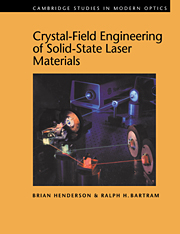Book contents
- Frontmatter
- Contents
- Preface
- 1 An introduction to lasers
- 2 Symmetry considerations
- 3 Optical crystals: their structures, colours and growth
- 4 Energy levels of ions in crystals
- 5 Spectra of ions in crystals
- 6 Radiationless transitions
- 7 Energy transfer and excited state absorption
- 8 Covalency
- 9 Engineering the crystal field
- 10 The crystal field engineered
- References
- Index
10 - The crystal field engineered
Published online by Cambridge University Press: 24 September 2009
- Frontmatter
- Contents
- Preface
- 1 An introduction to lasers
- 2 Symmetry considerations
- 3 Optical crystals: their structures, colours and growth
- 4 Energy levels of ions in crystals
- 5 Spectra of ions in crystals
- 6 Radiationless transitions
- 7 Energy transfer and excited state absorption
- 8 Covalency
- 9 Engineering the crystal field
- 10 The crystal field engineered
- References
- Index
Summary
The successful launch of the alexandrite laser by Allied Chemicals Inc. and the elucidation of essential design parameters [Walling et al. (1979), (1980)] spawned rapid growth of research into Cr3+-based lasers [Caird and Payne (1991)]. Possible alternative gain media to alexandrite included the Cr3+-doped garnets [Struve and Huber (1985)]. However, the development of Cr3+ : colquiriite lasers at Lawrence Livermore National Laboratory [Payne et al. (1988a), (1989a)] deflected attention away from the Cr3+ garnets, these mixed fluoride gain media being as efficient as alexandrite and almost as broadband as Ti-sapphire. Two distractions from the dominance of Cr3+ ion broadband tunable lasers were the inventions of the Ti-sapphire (Ti3+ : Al2O3) [Moulton (1982a,b)] and the Cr4+ : forsterite [Petricevic et al. (1988)] lasers. At present Ti3+ : Al2O3 and Nd3+ : YAG are the market leaders in solid state laser production against which new developments are assessed. Their pre-eminence derives in part from the quality and quantity of laser rods that can be produced at modest cost. Both materials have excellent photothermal and thermomechanical properties, and are robust components under laser operating conditions. However, despite much spectroscopic research Ti-sapphire is still the only usable Ti3+-activated solid state laser. In contrast, operation of several 3d2-ion doped lasers have been reported giving broadband tunability at near-infrared wavelengths (1.0–1.7 μm) which have potential applications in optical communications, medical sciences and on remote sensing LIDAR platforms.
- Type
- Chapter
- Information
- Crystal-Field Engineering of Solid-State Laser Materials , pp. 301 - 371Publisher: Cambridge University PressPrint publication year: 2000



